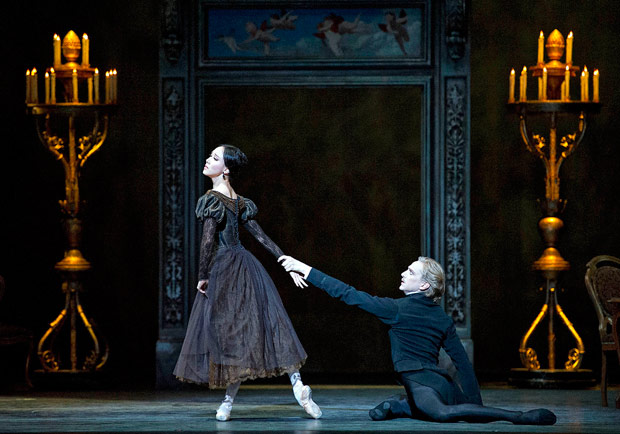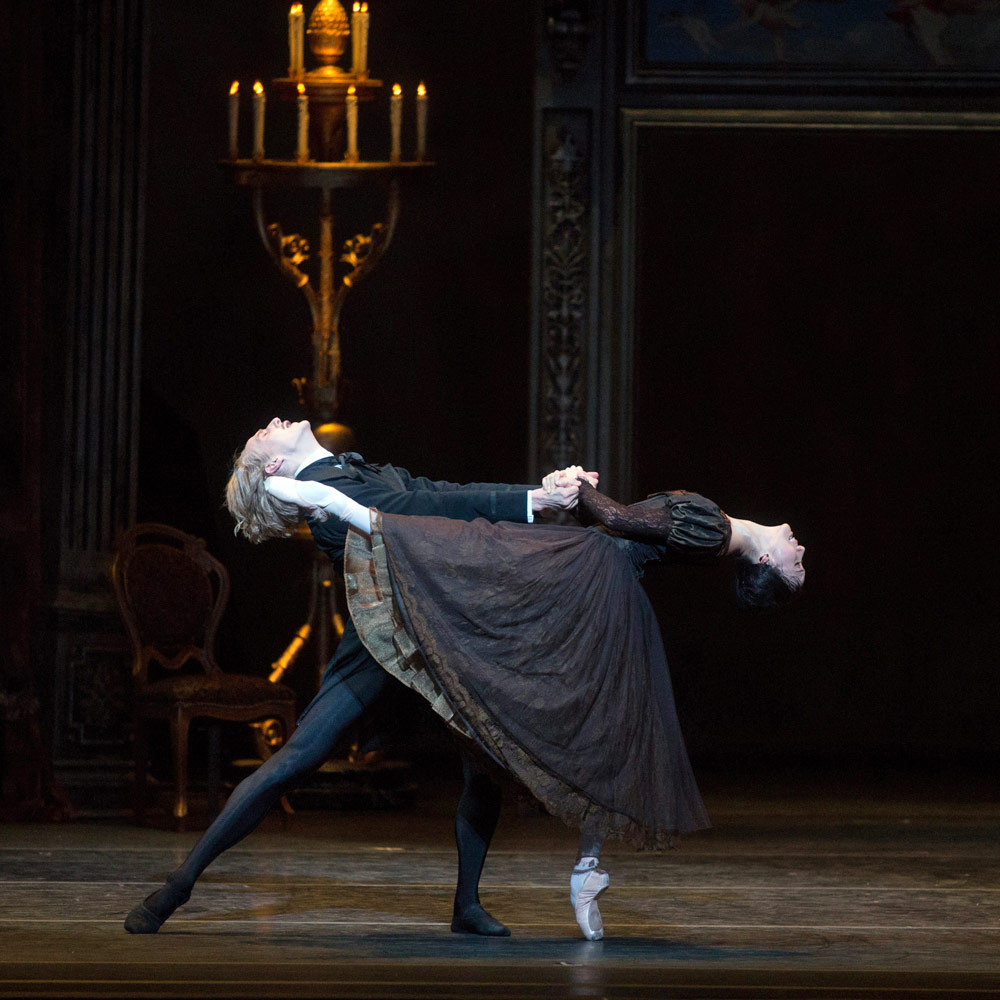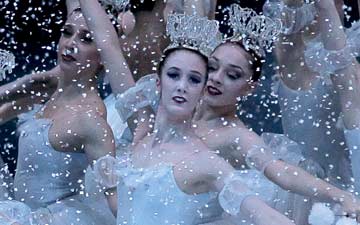
© Rosalie O’Connor. (Click image for larger version)
American Ballet Theatre
Onegin
★★★✰✰
New York, Metropolitan Opera House
21 June 2017
www.abt.org
Love Scorned
Since its composition in 1825, Alexander Pushkin’s book in verse about a bored St. Petersburg dandy, “Eugene Onegin,” has captured the imaginations of dramatists and composers. Pyotr Tchaikovsky’s opera is one of that composer’s greatest, most gripping compositions. What is it about this character, who on the surface seems so unappealing, that pulls at our heartstrings so?
Perhaps it is Pushkin’s portrait of tragically missed opportunity, a situation that almost anyone can identify with. A sensitive young girl (Tatiana) becomes infatuated with a handsome stranger (Eugene Onegin). He brushes her off, cruelly. His bored dalliance with another woman (Tatiana’s sister) leads to a duel, and the death of a passionate young man. Years later, Onegin returns. Tatiana is happily married; he is filled with regret. Now it is he who desires her, but it’s too late. You can’t mend what’s broken.
In 1965, the South African-born choreographer John Cranko turned the story into a three-act ballet for the company he was then leading, Stuttgart Ballet. Ignoring the music from Tchaikovsky’s opera, Cranko cobbled together orchestrations of various Tchaikovsky piano pieces and excerpts from other operas (Francesca da Rimini, Tcherevitski, an unfinished Romeo and Juliet). Cranko’s ballet has since become a mainstay of the repertory. Every ballerina, it seems, wants to dance the role of the forlorn Tatiana; it is one of those roles that allows a dancer to give full expression to her dramatic side and to really let her hair down. The role of Onegin is harder to cast; he must come across as detached but not completely unsympathetic. His transformation from indifferent stranger to desperate supplicant in the final scene must be believable. Few dancers pull it off credibly.
There is also a question of language. How does one translate Pushkin’s elegant, somewhat ironic tone into ballet steps? Cranko opted for a naturalistic approach, influenced by the dramatic ballets brought to Western Europe by the Bolshoi in the fifties. Emotions are writ large. The ballet hinges on two pas de deux in which the steps are executed with broad, impulsive strokes. The impression, at least, must be one of complete abandon. One leap, swoon, or dramatic lift follows upon the other. The dancers throw themselves at each other’s feet, open their eyes and mouths wide in desperation, hold their hands out imploringly. In the final pas de deux, especially, Tatiana repeatedly hangs limply on Onegin’s arms, as if impaled. Onegin prostrates himself at her feet, crawls on his knees. The men are given to soliloquies, usually filled with aching arabesques.
Which is to say that there is much melodrama. To be fair, there are lighter parts as well: Olga, Tatiana’s sister, dances a lovely pas de deux to a lilting Russian melody with her beau, Lensky, in the first act. And Tatiana has an even lovelier one, a glowing depiction of mutual understanding and care, with her husband Prince Gremin in Act III. There are inconsequential “Russian” dances, and later a mazurka and a stately polonaise. But it is the melodrama that people remember and are drawn to in Onegin.
This kind of melodrama isn’t everyone’s cup of tea, and I place myself among those who feel that Cranko’s Onegin steps over the line. The two passionate pas de deux certainly hammer home the point that this is a doomed, life-consuming passion, but do they need to hammer quite so insistently? Tatiana is swung, pulled, impaled (see above), and flung in every possible way. One can only imagine the bruises. The two pas de deux amount to a cascade of neverending crescendi, with little subtlety or, actually, genuine feeling. Instead, it becomes almost a cartoon of emotion.

© Rosalie O’Connor. (Click image for larger version)
This week, Cranko’s ballet is being performed at American Ballet Theater. On the 21st I caught a cast that included David Hallberg in the title role, with Hee Seo as Tatiana. The rest of the cast was all new: Skylar Brandt as Tatiana’s flighty sister Olga; Jefffrey Cirio as Lensky, her hotheaded beau; and Thomas Forster as the kind, impeccably-mannered Prince Gremin, the man who picks up the pieces of the mess left by Onegin.
It was a solid performance, though Brandt might consider reining in her natural tendency to smile with equal sunniness in every scene. She is a lovely, sprightly, quick-footed dancer with a wonderfully readable face and big eyes. She doesn’t need the extra wattage; in fact, in a role like this one, it lessens her sparkle and robs her of depth. Cirio, an admirable dancer of short stature, made much of his clean technique to lengthen his line in the role’s many sustained arabesques. Now, he could smooth out the transitions between steps, creating a more singing melody. Lensky’s soliloquy is like a tenor’s aria; it’s his “Furtiva Lacrima”. Legato is all. Tom Forster, a sensitive actor and gracious partner, is a good fit for Prince Gremin, though he looked a bit young in the role. He and Seo gave the impression of being almost bride and groom, not the mature married couple of Pushkin’s story. (Many years have passed between the duel and the final scene at Gremin’s palace.) But Forster’s youthfulness made the following scene, in which Tatiana implores him to stay at her side in order to avoid Onegin’s visit, all the more touching. (Even though the long military coat he wore in that scene looked several sizes too large!)
Which brings us to the leads. One could say that Hallberg, a veteran of Onegin, was born to play this role. Who is more elegant or refined than Hallberg, with his whisper-thin physique and his infinitely long lines, the delicacy and expressiveness of his feet, the nobility of his brow? The arabesque line in his turns could make any girl weep. And when called for, he can really pull off a poète maudit: every entrance, cape billowing around him, haunted eyes looking off into the middle distance, is worthy of Wuthering Heights. His acting, since his two-year-long forced layoff caused by a serious injury to his foot – appears to have become more relaxed and focused. Equally importantly, his partnering has improved by leaps and bounds. The partnering in Onegin is brutal, and he and Seo pulled it off with no major hitches, though you could see them thinking a lot, especially in the first bedroom pas de deux. They’re not yet able to maintain their characters at full tilt while doing all that heavy lifting. (For that, see Diana Vishneva and Marcelo Gomes later this week. It is her farewell from ABT. It promises to be heavy.)
Seo, as elegant and elongated in physique as Hallberg, dances the role with great delicacy and inwardness, avoiding, to the extent that the ballet allows, overacting. She is especially effective in the still moments, when she is able to really give the impression of receding into her inner world. The expression on her face after reading Onegin’s regretful letter was haunting in the extreme; it was as if the life had suddenly been drained out of her. Even more impressive – she did this without any real external change in her demeanor. She just stood there, stunned. She was also touching in the pas de deux with Gremin, resting her head on his chest with what looked like real affection, walking slowly, comfortably, on her pointes to show the inner peace attained after her great humiliation. Through her dancing she revealed the poised, but still sincere, woman who had emerged from the ashes of young Tatiana’s love.
It is in moments like this that Cranko’s Onegin transcends its melodramatic disposition and becomes, paradoxically, a genuinely moving work.

















You must be logged in to post a comment.